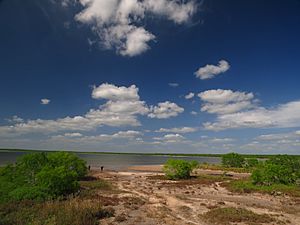Lower Rio Grande Valley National Wildlife Refuge facts for kids
Quick facts for kids Lower Rio Grande Valley National Wildlife Refuge |
|
|---|---|
|
IUCN Category IV (Habitat/Species Management Area)
|
|

El Sal Del Rey inside the Lower Rio Grande Valley National Wildlife Refuge.
|
|
| Location | Cameron, Hidalgo, Starr, Zapata counties, Texas, United States |
| Nearest city | La Feria, Texas |
| Area | 90,788 acres (367.41 km2) |
| Established | 1979 |
| Governing body | U.S. Fish and Wildlife Service |
| Website | Lower Rio Grande Valley National Wildlife Refuge |
The Lower Rio Grande Valley National Wildlife Refuge is a huge natural area in southern Texas. It covers about 90,788 acres, which is like 68,000 football fields! This special place is a National Wildlife Refuge, meaning it's protected to help animals and plants thrive. You can find it along the northern side of the Rio Grande river, close to the border with Mexico.
The refuge was created in 1979. Its main goal is to protect the unique habitats and wildlife found in the Lower Rio Grande Valley. It's managed by the United States Fish and Wildlife Service.
Amazing Wildlife and Plants
The Lower Rio Grande Valley National Wildlife Refuge is home to an incredible variety of living things. Even though only a small part of the original natural areas are left, these spots are super important. They support a huge number of different species.
Plants and Habitats
You can find about 1,200 different kinds of native plants here. The refuge has many different types of natural environments, called "biological communities." These range from dry thorn forests, like those in the Chihuahuan Desert, to wet areas near the coast called tidal wetlands.
These different habitats include:
- Areas along rivers, called riparian zones
- Floodplains, which are flat lands next to rivers that sometimes flood
- Wetlands, which are areas where the land is covered by water, like swamps or marshes
Animals of the Refuge
The refuge is a safe place for many animals. There are about 700 different kinds of vertebrates (animals with backbones). This includes almost 500 types of birds! Plus, there are 300 different kinds of butterflies.
Some of the special animals you might find here include:
- The rare ocelot, a wild cat
- The crested caracara, a type of falcon
- The Mexican bluewing butterfly (Myscelia ethusa)
- The great kiskadee, a colorful bird
- The red-billed pigeon
- The Altamira oriole, another bright bird
- The ringed kingfisher
- The green jay, a very colorful bird
The refuge is also part of the Great Texas Coastal Birding Trail. This is a special network of places where people can go to watch birds all along the Texas coast. It's a fantastic spot for birdwatchers of all ages!



